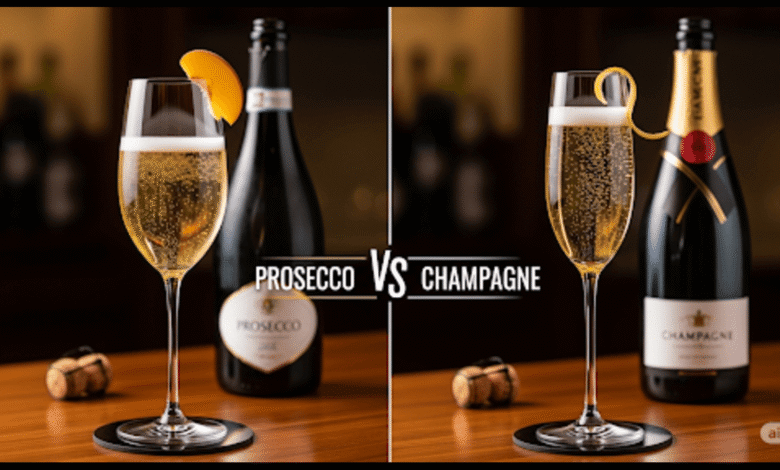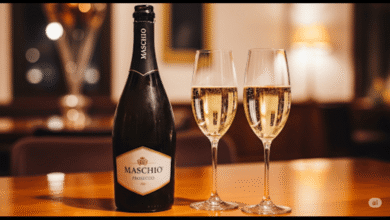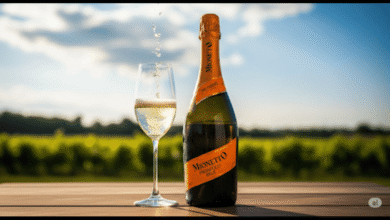Prosecco vs Champagne: What’s the Real Difference?

When it comes to celebrating life’s special moments, sparkling wine is the go-to choice. But step into any wine shop or restaurant and you’ll face the classic conundrum: Prosecco or Champagne? While both bring bubbles and elegance to the table, they’re not as interchangeable as they might seem.
In this guide, we’ll break down the key differences between Prosecco vs Champagne, from how they’re made to how they taste, their price points, and when to choose one over the other. Plus, we’ve added a handy FAQ section to clear up the most common questions.
What Is Champagne?
Champagne is a sparkling wine that can only be produced in the Champagne region of France, under strict regulations. Made using the traditional method (méthode champenoise), Champagne is aged with yeast in the bottle to develop its complex, toasty character.
It’s crafted mainly from Chardonnay, Pinot Noir, and Pinot Meunier grapes and is known for its fine bubbles, depth, and aging potential.
What Is Prosecco?
Prosecco is Italy’s famous sparkling wine, made primarily from Glera grapes in the Veneto and Friuli regions. It uses a tank fermentation method (Charmat method), which is quicker and more affordable than the traditional Champagne method.
Prosecco is typically lighter, fruitier, and more floral, with an approachable, easy-drinking style.
Prosecco vs Champagne: Key Differences
| Feature | Champagne | Prosecco |
|---|---|---|
| Origin | Champagne, France | Veneto & Friuli, Italy |
| Grapes Used | Chardonnay, Pinot Noir, Pinot Meunier | Primarily Glera |
| Production Method | Traditional (bottle fermentation) | Charmat (tank fermentation) |
| Taste | Complex, yeasty, nutty, citrusy | Light, fruity, floral, crisp |
| Bubbles | Finer, longer-lasting | Frothier, lighter |
| Aging Potential | High—can age for years | Best enjoyed young |
| Price Range | Expensive (often $40–$100+) | Affordable (often $10–$25) |
Taste Comparison
- Champagne: Expect to taste hints of brioche, almond, citrus, green apple, and mineral notes. The aging process gives it a toasty richness and depth.
- Prosecco: Lighter and fruit-forward, with flavors like pear, melon, white peach, apple, and sometimes floral hints like honeysuckle or orange blossom.
When to Choose Champagne vs Prosecco
- Choose Champagne if…
You’re celebrating a major life event like a wedding, anniversary, or New Year’s Eve and want something refined and luxurious. - Choose Prosecco if…
You’re having brunch, a casual gathering, or just want something light, refreshing, and easy on the wallet.
Pairing Ideas
- Champagne goes beautifully with oysters, caviar, fried chicken, creamy cheeses, and seafood.
- Prosecco shines with prosciutto, fruit-based appetizers, sushi, or lighter pastas.
Prosecco vs Champagne FAQs
Q1: Is Champagne stronger than Prosecco?
A: Both usually contain similar alcohol levels—around 11–12.5% ABV. However, Champagne may feel stronger due to its more intense flavor profile and acidity.
Q2: Why is Champagne more expensive than Prosecco?
A: Champagne is made using a longer, more labor-intensive process and aged for a longer period. It also comes from a smaller, regulated region, which adds to its exclusivity and price.
Q3: Can you use Prosecco instead of Champagne for mimosas?
A: Yes, and many people prefer it! Prosecco is sweeter and fruitier, making it perfect for mimosas, Bellinis, or other sparkling cocktails.
Q4: Is Prosecco sweeter than Champagne?
A: Generally, yes. Prosecco tends to be off-dry to semi-sweet, while most Champagne is brut (dry). But both wines come in a range of sweetness levels—always check the label!
Q5: What does “Brut” mean in Prosecco and Champagne?
A: “Brut” indicates a dry wine with little residual sugar. Both Prosecco and Champagne can be labeled Brut, which means they’re not sweet. Sweeter versions are labeled “Extra Dry,” “Demi-Sec,” or “Sec.”
Q6: Which has more calories—Champagne or Prosecco?
A: Both are similar in calories. A standard glass (about 5 oz) has roughly 90–120 calories, depending on sugar content and alcohol level.
Q7: Does Prosecco age like Champagne?
A: No. Prosecco is best consumed young (within 1–2 years) for its fresh, fruity flavor. Champagne can age gracefully for years, developing complex secondary aromas.
Final Thoughts
The Prosecco vs Champagne debate doesn’t have a winner—just different experiences. Champagne offers elegance, complexity, and celebration. Prosecco brings joy, freshness, and everyday sparkle. Whether you’re toasting a milestone or sipping during Sunday brunch, there’s a bubbly for every moment.
At the end of the day, it’s not about which one is better, but which one is right for you. And if you’re still unsure? Have a glass of each—and enjoy the journey.




